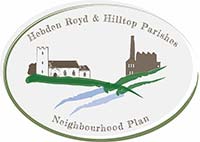 Neighbourhood Plan: Climate Change, Flooding & Landscape
Neighbourhood Plan: Climate Change, Flooding & Landscape
Friday, 5 March 2021
This is the second in a series of weekly articles about specific aspects of the Neighbourhood Plan, to guide you through the detail and prompt some thoughts for your consultation response. Do you agree or disagree with what’s proposed? Have you other suggestions? There’s a discussion forum thread for any comments or ideas.
The draft Neighbourhood Plan is a spatial plan, and a primary characteristic of our Neighbourhood Plan is just how much space it covers: 11,600 hectares, and almost one third of the borough of Calderdale. There are two other characteristics which it recognises are equally important: the topography of the area and the necessary interaction between what happens in the uplands and in the valley bottom; and - as revealed by the biodiversity and ecological assessment commissioned by the plan - that just 3% of the total area is covered by urban settlements, with the predominant land use being moorland - 48% blanket bog and 18% upland heath – and other large land uses: grassland 21% and woodland 9% Neighbourhood Plan paragraph 3.9. Converting those statistics into the places we live in and view, they constitute the precious landscape over which the NP has to exercise proper stewardship.
Equally critical for the content of the Neighbourhood Plan is the urgent necessity for it to respond to climate change (the ‘climate emergency’ declared by Hebden Royd Town Council in March 2019, and Blackshaw parish council in 2020): a global phenomenon which is threatening our local communities in a particularly destructive way - the catastrophic flood events of 2000, 2012, 2015 and most recently 2020. The national planning policy framework requires that an Neighbourhood Plan should ‘shape places in ways that contribute to radical reductions in greenhouse gas emissions, minimise vulnerability and improve resilience’ NPPF 148.
So the draft Neighbourhood Plan devotes section 13 to climate and flooding, and section 14 to environment and landscape page 56 onwards. One of the key reasons for developing a neighbourhood plan encompassing both valley-bottom settlements and their upland catchments was in recognition of their respective contributions to flood causation and carbon solutions. Flood risk originating in the uplands but impacting upon the lowlands needs to be tackled in both locations, with a single plan; whilst the huge potential for increased carbonsequestration in moorland peat bogs, and more tree planting on the slopes, has to be understood to be just as important as increased energy efficiency in homes and businesses.
Most of the Neighbourhood Plan area is covered by the highest designations for nature protection: a Special Protection Area under the Bird Directive for international importance for ground nesting birds, a Special Area for Conservation under the Habitats Directive to protect valuable blanket bog, a site of special scientific interest (SSSI), and a Special Landscape Area. Despite this protective status the ecological scoping desk study found that the majority of our moorland habitat is in a degraded condition, whilst preliminary analysis of Calderdale’s radical carbon reduction requirements has found that the district’s peatlands are emitting, not sequestrating, CO2. Fortunately, when the government recently announced measures to ban the practice of moorland burning on areas of deep peat more than 40cm in depth - but only in those locations which are SPAs/SCAs/SSSIs - it seemed to indicate that this protection will now be applied to our moors. Policy 27 sets out the proposed approach for protection and enhancement of the uplands, whilst for locations in the valley bottom and close to or within urban areas policy 28 encourages the improvement of sites like Mayroyd (Hebden Bridge) and Brearley Fields (Mytholmroyd - as it happens a scheme already being implemented).
In the context of the catchment-level strategies and infrastructure programmes to mitigate flooding prepared by the Environment Agency, Calderdale Council and Yorkshire Water, the Neighbourhood Plan in policy 24 gives its support to the £39m flood alleviation scheme for Hebden Bridge (following on from the FAS for Mytholmroyd already completed), the determined community and volunteering initiatives to ‘slow the flow’ in the uplands and on the valley slopes; and completion of the trial scheme whereby water levels in the reservoirs above Hebden Bridge are reduced by 10% in volume in times of anticipated heavy rainfall in order to temporarily hold back moorland run-off.
The Neighbourhood Plan notes that, regrettably, both the national and Calderdale planning frameworks do not at the moment allow neighbourhood plans to require energy efficiency standards for new housing development that push towards zero carbon (though they can be more demanding in the case of the non-residential development). Making the best of this situation the draft plan proposes that - via the mechanism of a ‘design and standards code’ that can be updated to take account of (we hope) constantly improving requirements for greater energy efficiency - the NP will in due course be able to set the high standards that local people support - policies 25 and 33.
Do the proposals of the Neighbourhood Plan to protect our environment, prevent flooding and respond to climate change go far enough? Have you got suggestions you’d like to make? Why not contribute to the Hebweb discussion thread especially created for this topic?
See also
HebWeb News: Neighbourhood Plan: Regeneration and new housing 26 Feb 2021
HebWeb News: 10 things to know about the Neighbourhood Plan 18 Feb 2021
HebWeb News: Launch of public consultation for new Neighbourhood Plan 17 Feb 2021
The Headlines or main points of the Neighbourhood Plan

